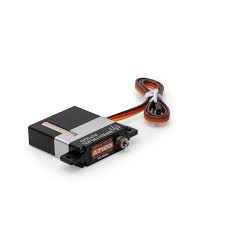The Essential Guide to RC Servos
RC servos are a crucial component in the world of radio-controlled vehicles, providing precise control over steering, throttle, and other functions. Understanding how servos work and choosing the right one for your RC model is essential for optimal performance. Let’s delve into the world of RC servos to uncover their importance and functionality.
What are RC Servos?
An RC servo is a small device that translates electrical signals into precise mechanical movement. It consists of a motor, gears, and a control circuit housed within a compact casing. Servos are commonly used in RC cars, planes, boats, and other vehicles to control various functions such as steering, throttle, and flight surfaces.
How Do RC Servos Work?
When an electrical signal is sent to an RC servo from the receiver unit of the radio transmitter, the control circuit processes the signal and commands the motor to move to a specific position. The motor turns gears inside the servo, which in turn move the output shaft connected to the control surface or mechanism on the RC vehicle.
Types of RC Servos
There are several types of RC servos available on the market, each designed for specific applications:
- Analogue Servos: Traditional servos that operate based on pulse width modulation (PWM) signals.
- Digital Servos: Offer faster response times and higher precision compared to analogue servos.
- High-Torque Servos: Designed for applications requiring greater force or torque output.
- Metal Gear Servos: Feature metal gears for increased durability and strength.
Choosing the Right RC Servo
When selecting an RC servo for your vehicle, consider factors such as torque rating, speed, size, compatibility with your receiver system, and budget. It’s essential to choose a servo that matches your specific needs and provides reliable performance under various conditions.
Conclusion
In conclusion, RC servos play a vital role in controlling the movement of radio-controlled vehicles with precision and accuracy. By understanding how servos work and selecting the right type for your application, you can enhance the performance of your RC model and enjoy a more immersive driving or flying experience.
Top 5 Tips for Optimal RC Servo Performance and Maintenance
- Ensure the servo is compatible with your receiver and transmitter.
- Calibrate the servo to its neutral position before use.
- Avoid overloading the servo to prevent damage.
- Regularly check and maintain the gears for smooth operation.
- Use a suitable power source within the recommended voltage range.
Ensure the servo is compatible with your receiver and transmitter.
It is crucial to ensure that the RC servo you choose is compatible with both your receiver and transmitter systems. Compatibility between the servo, receiver, and transmitter ensures seamless communication and optimal performance of your radio-controlled vehicle. Before purchasing a servo, carefully check its specifications to confirm that it is suitable for use with your existing radio control equipment. By ensuring compatibility, you can avoid potential issues and enjoy a smooth operation of your RC model.
Calibrate the servo to its neutral position before use.
It is essential to calibrate the servo to its neutral position before use. By calibrating the servo, you ensure that it is correctly centered and ready to provide accurate control over your RC vehicle’s functions. Setting the neutral position helps prevent any potential drift or inaccuracies in the servo’s movement, allowing for smoother and more precise operation during your RC racing or flying sessions. Taking the time to calibrate your servo before use can significantly improve the overall performance and responsiveness of your radio-controlled model.
Avoid overloading the servo to prevent damage.
It is important to avoid overloading the servo in your RC vehicle to prevent potential damage. Overloading can put excessive strain on the servo motor and gears, leading to premature wear and potential failure. By ensuring that the servo is not tasked with functions beyond its specified capabilities, you can prolong its lifespan and maintain optimal performance in your radio-controlled model.
Regularly check and maintain the gears for smooth operation.
It is essential to regularly inspect and maintain the gears of your RC servos to ensure smooth operation and longevity. Gears are crucial components that enable the servo motor to translate electrical signals into mechanical movement accurately. By checking for any signs of wear, dirt, or misalignment in the gears, you can prevent potential issues such as reduced performance or gear stripping. Regular maintenance, such as cleaning and lubricating the gears, will help keep your RC servos operating smoothly and efficiently during your racing or flying sessions.
Use a suitable power source within the recommended voltage range.
It is crucial to use a suitable power source within the recommended voltage range when operating RC servos. Exceeding the specified voltage can lead to overheating, reduced servo lifespan, or even permanent damage. By following the manufacturer’s guidelines and ensuring that the power source falls within the recommended range, you can maintain optimal performance and longevity of your servos, ensuring smooth and reliable operation of your radio-controlled vehicle.

